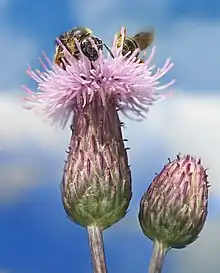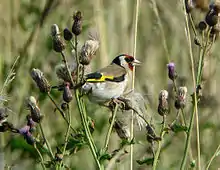丝路蓟
絲路薊(学名:),又名田薊[1][2][3]或加拿大薊[4],是一種分佈在歐洲及亞洲北部的薊屬,並且廣泛引進到其他地方。雖然在北美洲一般稱它為加拿大薊,但是並非來自加拿大。[5]
| 絲路薊 | |
|---|---|
 | |
| 科学分类 | |
| 界: | 植物界 Plantae |
| 演化支: | Tracheophyta |
| 演化支: | 被子植物 Angiosperms |
| 演化支: | 真双子叶植物 Eudicots |
| 演化支: | 菊类植物 Asterids |
| 目: | 菊目 Asterales |
| 科: | 菊科 Asteraceae |
| 属: | 薊屬 Cirsium |
| 种: | 絲路薊 C. arvense |
| 二名法 | |
| Cirsium arvense (L.) Scop. | |
| 變種 | |
| |
- Cirsium arvense var. arvense:分佈在歐洲大部份地方。葉子下方沒有毛。
- Cirsium arvense var. incanum:分佈在歐洲南部。葉子下方有厚毛。
形态
絲路薊是高的草本多年生植物,從地下的根系統形成大型的克隆群落,並於每年春天長出1-1.2米高的莖。於夏天,莖很多是會部份躺下,若有其他植物支撐,則仍會保持挺直。葉子有很多尖刺,長15-20厘米及闊2-3厘米。花序的直徑長1-2.2厘米,所有小花的形狀相似。花朵一般都是雌雄異體的,但並非沒有不同,其中一些植株則會有雌雄同體的花朵。種子長4-5毫米,有冠毛,可以經風力傳播。[3][6][7]
生態

正在吃絲路薊種子的金翅雀。
絲路薊的種子是歐洲金翅雀及赤胸朱頂雀的重要食物,亦是其他雀科的食物之一。[8]絲路薊葉子是鱗翅目超過20個物種及一些蚜蟲的食物,當中包括小紅蛺蝶及埃尺蛾等。[9][10][11]
狀況
絲路薊一直被廣泛認為是一種野草,如在英國,它就被定為「有害的野草」。[12]它們在很多地區亦是嚴重入侵物種,一般是作為糧食種子的污染物而被引入這些地區。在很多國家,如澳洲、巴西、加拿大[13]、新西蘭及美國都將它定為有害的野草,一些國家甚至限制它們或其部份的引入。
參考
- Joint Nature Conservation Committee: Cirsium arvense (页面存档备份,存于)
- Botanical Society of the British Isles Database (页面存档备份,存于)
- Flora of Northwest Europe: Cirsium arvense (页面存档备份,存于)
- . [2008-07-05]. (原始内容存档于2008-06-01).
- Invasive and Problem Plants of the United States: Cirsium arvense (页面存档备份,存于)
- Blamey, M. & Grey-Wilson, C. . Great Britain: Hodder and Stoughton Ltd. 1989. ISBN 0-340-40170-2.
- KAY, Q. O. N. . New Phytologist (Wiley). 1985, 100 (3): 457–472. ISSN 0028-646X. doi:10.1111/j.1469-8137.1985.tb02794.x.
- Cramp, S., & Perrins, C. M. . Oxford: Oxford University Press. 1994.
- Finnish Lepidoptera Cirsium arvense (页面存档备份,存于)
- The Ecology of Commanster: Cirsium arvense (页面存档备份,存于)
- Ecological Flora of the British Isles: Phytophagous Insects for Cirsium arvense (页面存档备份,存于)
- DEFRA: Identification of injurious weeds (页面存档备份,存于)
- Canada Gazette: Weed Seeds Order 2005 (页面存档备份,存于)
- Plants for a Future: Cirsium arvense (页面存档备份,存于)
This article is issued from Wikipedia. The text is licensed under Creative Commons - Attribution - Sharealike. Additional terms may apply for the media files.